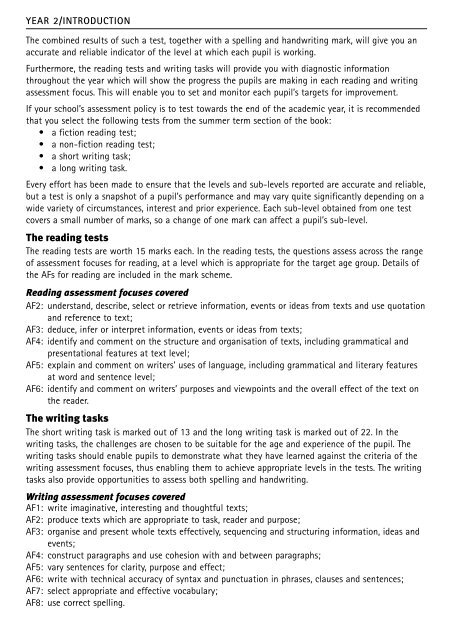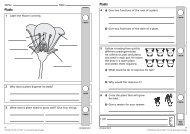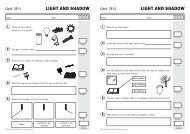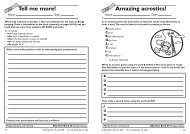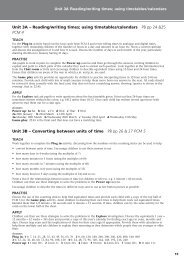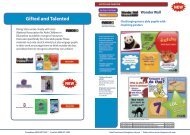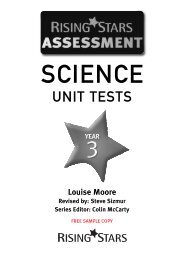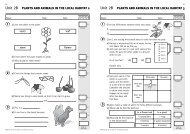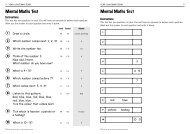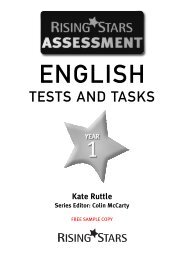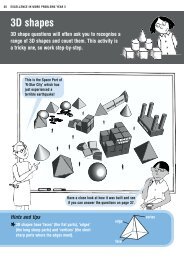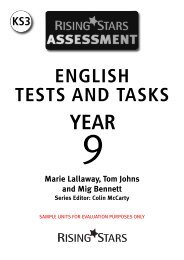TESTS AND TASKS - Rising Stars
TESTS AND TASKS - Rising Stars
TESTS AND TASKS - Rising Stars
- No tags were found...
You also want an ePaper? Increase the reach of your titles
YUMPU automatically turns print PDFs into web optimized ePapers that Google loves.
YEAR 2/INTRODUCTIONThe combined results of such a test, together with a spelling and handwriting mark, will give you anaccurate and reliable indicator of the level at which each pupil is working.Furthermore, the reading tests and writing tasks will provide you with diagnostic informationthroughout the year which will show the progress the pupils are making in each reading and writingassessment focus. This will enable you to set and monitor each pupil’s targets for improvement.If your school’s assessment policy is to test towards the end of the academic year, it is recommendedthat you select the following tests from the summer term section of the book:• a fiction reading test;• a non-fiction reading test;• a short writing task;• a long writing task.Every effort has been made to ensure that the levels and sub-levels reported are accurate and reliable,but a test is only a snapshot of a pupil’s performance and may vary quite significantly depending on awide variety of circumstances, interest and prior experience. Each sub-level obtained from one testcovers a small number of marks, so a change of one mark can affect a pupil’s sub-level.The reading testsThe reading tests are worth 15 marks each. In the reading tests, the questions assess across the rangeof assessment focuses for reading, at a level which is appropriate for the target age group. Details ofthe AFs for reading are included in the mark scheme.Reading assessment focuses coveredAF2: understand, describe, select or retrieve information, events or ideas from texts and use quotationand reference to text;AF3: deduce, infer or interpret information, events or ideas from texts;AF4: identify and comment on the structure and organisation of texts, including grammatical andpresentational features at text level;AF5: explain and comment on writers’ uses of language, including grammatical and literary featuresat word and sentence level;AF6: identify and comment on writers’ purposes and viewpoints and the overall effect of the text onthe reader.The writing tasksThe short writing task is marked out of 13 and the long writing task is marked out of 22. In thewriting tasks, the challenges are chosen to be suitable for the age and experience of the pupil. Thewriting tasks should enable pupils to demonstrate what they have learned against the criteria of thewriting assessment focuses, thus enabling them to achieve appropriate levels in the tests. The writingtasks also provide opportunities to assess both spelling and handwriting.Writing assessment focuses coveredAF1: write imaginative, interesting and thoughtful texts;AF2: produce texts which are appropriate to task, reader and purpose;AF3: organise and present whole texts effectively, sequencing and structuring information, ideas andevents;AF4: construct paragraphs and use cohesion with and between paragraphs;AF5: vary sentences for clarity, purpose and effect;AF6: write with technical accuracy of syntax and punctuation in phrases, clauses and sentences;AF7: select appropriate and effective vocabulary;AF8: use correct spelling.


